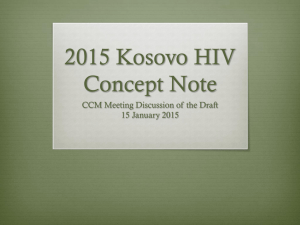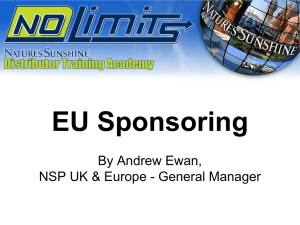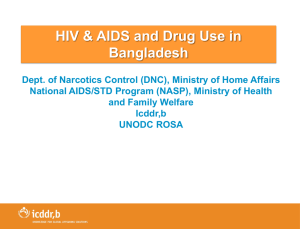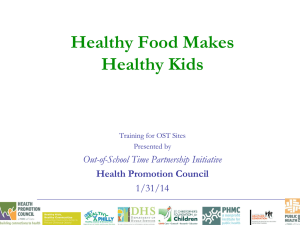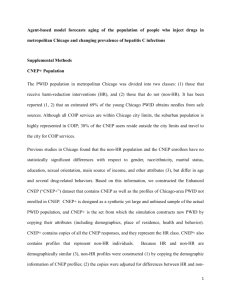Slide 1
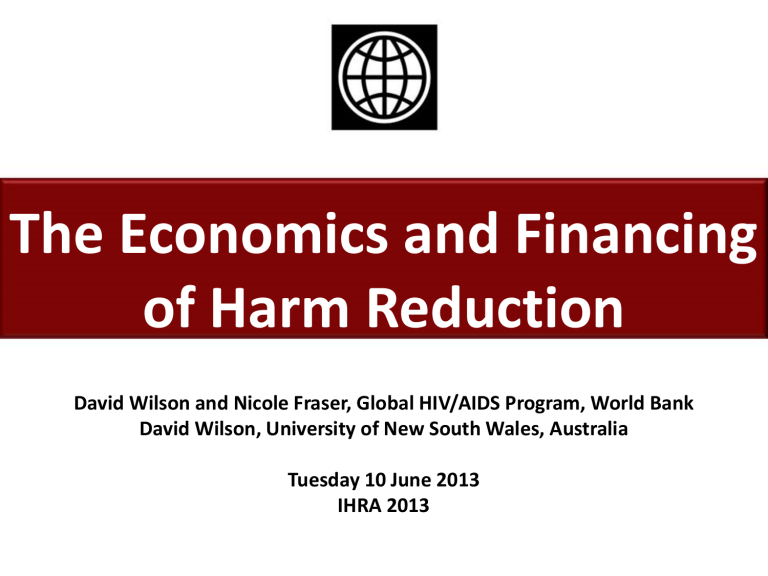
The Economics and Financing of Harm Reduction
David Wilson and Nicole Fraser, Global HIV/AIDS Program, World Bank
David Wilson, University of New South Wales, Australia
Tuesday 10 June 2013
IHRA 2013
Overview
Why worry?
What works and what does it cost?
What’s the coverage?
How much is spent on harm reduction?
How much is needed to scale-up harm reduction?
What’s the cost-effectiveness/return on investment?
Why worry?
Prevalence of Injecting Drug Use
Mathers et al, Lancet (2008)
Prevalence of HIV among PWID
Mathers et al, Lancet (2008)
80%
HIV prevalence among PWID in
Eastern and Central Asia
72%
60%
40%
20%
0%
0% 0,40% 0,60% 1,40% 1,50% 1,60%
2,14%
5,00%
8% 8,15% 9,20%
13% 13,40%
15% 15,60%
17%
37,20%
42%
Source: Bradley Mathers, Lancet 2008
HIV infections in PWID as share of infections in Eastern Europe and Central Asia
80%
70%
60%
50%
40%
30%
20%
10%
0%
28%
33%
36% 36%
38%
49%
54%
57%
62%
66%
67%
69%
77%
Source: Own calculation based on data from EuroHIV (2007)
HIV prevalence among sex workers in
Central Asia
Surging HIV epidemic among PWID in
Greece
HIV, HCV and TB
• PWID have higher HCV and TB rates
• 10 million PWID may have HCV - surpassing
HIV infection
• HIV+ PWID 2 to 6-fold higher risk of TB infection
• TB risk 23-fold higher in prisons
Global State of Harm Reduction, 2012
What harm reduction interventions work and what do they cost?
Three proven priority interventions
NSP
OST
ART
WHO, UNODC and UNAIDS - three priority interventions plus HCT, condoms, IEC, STI,
HCV and TB prevention/treatment
What we know about NSP
Needles and
Syringes
Programs
Safe injection centers
No. of injecting episodes
No effect
No effect
Injecting risk behavior
Sexual risk
HIV incidence
Cost-effective
Tilson H. et al.
Institute of
Medicine 2007
Palmateer N. et al. Addiction
2010
Kerr T. et al.2007
Hedrich D. et al. 2010
Yes
Palmateer
N. et al.
Addiction
2010
Tilson H. et al.
Institute of
Medicine 2007
Jones L. et al.
2010
Yes
Andersen MA et al. 2010
Bayoumi AM,
Zarig GS 2008
Source: L. Degenhardt Lancet July 2010
What we know about NSP
HIV prevalence in 99 cities worldwide (MacDonald et al, 2003)
19% per year in cities with NSP
8% in cities without NSP
International evidence shows NSP effective (Wodak,
2008)
What we know about OST (versus compulsory detention)
No. of injecting episodes
Injecting risk behavior
Sexual risk
HIV incidence
Cost effective
OST
Tilson H. et al.
(2007)
Growing L. et al.
(2008)
Faggiano F. et al.
(2009)
Mattick RP et al.
(2009)
Tilson H. et al.
2007
Growing L. et al. (2008)
Yes
No effect
Tilson H. et al. (2007)
Sullivan LE.
Et al. (2005)
Tilson H. et al.
(2007)
No
Constella (2008)
Detention
WHO 2010
Pearshouse R. et al. 2010
Open Society
Institute (2010)
WHO 2010
Pearshouse R. et al. (2010)
OSI(2010)
Source: L. Degenhardt Lancet July 2010
What we know about OST (versus compulsory detention)
Compulsory detention common especially in Asia and Eastern Europe
Detention costly
Minimum cost $1,000 annually in Asia –
mainly security
Average OST cost $585 annually
Two evaluations in progress in Malaysia and Vietnam
Effectiveness of community OST versus compulsory detention
Preliminary data from Malaysia
95% relapse after compulsory detention
7% relapse in community OST
What we know about OST
All RCTs of OST positive (Mattick et al, 2003)
Large observational studies show OST decreases heroin use and criminal activity (Mattcick, 1998)
OST reduces injecting and increases safe injections (Cochrane Syst.
Review; Gowing, 2008; Mattick, 2009)
Amsterdam cohort study (Van den Berg, 2007) showed OST and
NSP reduced HIV incidence by 66%
Recent meta-analysis (Mcarthur BMJ2012) shows OST reduces HIV incidence by 50%
What we know about ART in PWID
What we know about combined NSP+OST+ART
Modelling evidence: NSP+OST+ART combination: 5-year impact on HIV incidence
Source: Degenhardt et al, 2010
What are the cost ranges?
NSP
NSP costs $23–71 /yr
1
, but higher if all costs included
NSP costs vary by region and delivery system (pharmacies, specialist programme sites, vending machines, vehicles or outreach)
NSP unit cost estimates, regional averages
2
180
160
140
120
100
80
60
40
20
0
70
21
62
158
62
15
South, Eas t &
SE As ia
Latin Am erica
& Caribbean
Middle Eas t &
North Africa
W Europe, N
Am erica &
Aus
E Europe &
Central As ia
Sub-Saharan
Africa
1
UNAIDS 2007 resource estimations; Schwartlaender et al 2011.
2
UNSW estimates, based on 10 studies identified in the 6 regions
What are the cost ranges?
OST
OST cost : Methadone 80 mg: $363 - 1,057 / yr; Buprenorphine, low dose: $1,236 – 3,167 /yr
1
Few OST cost studies but consistently far higher than NSP
OST unit cost estimates, regional averages
2
2,500
2,000
1,500
1,000
500
0
565
975
1,008
2,238
1,008
972
South, East &
SE Asia
Latin America
& Caribbean
Middle East &
North Africa
W Europe, N
America &
Aus
E Europe &
Central Asia
Sub-Saharan
Africa
1
UNAIDS 2007 resource estimations; Schwartlaender et al 2011.
2
UNSW estimates, based on 10 studies identified in the 6 regions
What are the cost ranges?
ART
ART cost: UNAIDS estimate $176
1
Estimated costs by authors $1,000-2,000 per HIV+
PWID
ART unit cost estimates, regional averages
2
1,800
1,600
1,400
1,200
1,000
800
600
400
200
0
885
1,305
1,127
1,600
1,305
1,189
South, Eas t &
SE As ia
Latin Am erica
& Caribbean
Middle Eas t &
North Africa
W Europe, N
Am erica &
Aus
E Europe &
Central As ia
Sub-Saharan
Africa
1
UNAIDS 2007 resource estimations; Schwartlaender et al 2011.
2
UNSW estimates, based on 10 studies identified in the 6 regions
What is the current coverage of NSP, OST and ART in PWID?
Harm reduction data challenges
Limited population size estimates
Inconsistent service quality data
Surveys miss hidden populations
ATS increasingly used and injected but missed in surveys
Significant but undocumented scale-down of services
Sources: UNGASS country progress reports 2012; Mathers et al., 2010; Global State of Harm Reduction, 2012
NSP coverage
86 countries and territories implement NSPs
3 new NSPs since 2010 – South Africa,
Tanzania, Laos-PDR
High coverage limited to Western Europe,
Australia and Bangladesh (>200 NS/PWID/year)
The Global State of Harm Reduction, 2012
NSP available as per policy
(Black: community and prison, red: community only)
Global State of Harm Reduction, 2012
Gaps in NSP coverage
NSP coverage < 20% in all regions - globally, <2 clean needles distributed /PWID /month
Since 2010, NSP provision scaled back in several countries in Asia (Pakistan, Nepal and Cambodia) and Eurasia (Belarus, Hungary, Kazakhstan,
Lithuania and Russia)
72 countries with PWID without NSPs
(1) Global State of Harm Reduction, 2012; (2) based on Mathers et al., 2010
Over 14 million PWID (90%) may not access NSP
-
Estimated NSP coverage of PWID in regions
3
2
1
5
4
4.005
2.911
3.287
2.160
1.777
0.119
S, E & SE
Asia
LA &
Caribbean
M-East & N-
Africa
W-Europe, N-
America &
Australasia
E-Europe &
C-Asia
PWID accessing NSP
SSA
NSP coverage gap (PWID in millions)
Source: Authors’ literature and estimations, based on Mathers et al., 2010
OST coverage
OST in 77 countries worldwide
7 new countries since 2010 (Cambodia,
Bangladesh, Tajikistan, Kenya, Tanzania, Macau,
Kosovo)
Primarily methadone and buprenorphine but also other formulations - slow-release morphine, codeine, heroin-assisted treatment
Global State of Harm Reduction, 2012
OST available as per policy
(Black: community and prison, red: community only)
Global State of Harm Reduction, 2012
Gaps in OST coverage
6–12% of PWID access OST
Coverage limited in much of CIS and Asia
OST unavailable in 81 countries with PWID
ATS use increasing – and limited ATS harm response
Global State of Harm Reduction, 2012
Almost 15 million PWID (92%) may not use OST
-
Estimated OST coverage of PWID in regions
5
4
3
2
1
4.260
2.531
3.689
2.202
1.777
0.120
S, E & SE
Asia
LA &
Caribbean
PWID accessing OST
M-East & N-
Africa
W-Europe, N-
America &
Australasia
E-Europe &
C-Asia
OST coverage gap (PWID in millions)
SSA
Source: Authors’ literature and estimates, using Mathers et al., 2010
ART coverage in HIV+ PWID
Large regional discrepancies
Uptake highest in Western Europe (89%) and
Australasia (50%)
Elsewhere ART coverage < 5%
Largest gaps in Eastern Europe & Central Asia
(1 million) and South, East & South-East Asia
(700,000)
Source: Authors literature review and estimates, using Mathers et al. 2010
About 2.5 million HIV+ PWID (85%) may not access ART
1,000,000
900,000
800,000
700,000
600,000
500,000
400,000
300,000
200,000
100,000
-
Estimated ART coverage in HIV+ PWID in regions
708,856
598,455
3,500
79,188
958,666
S, E & SE
Asia
LA &
Caribbean
M-East & N-
Africa
W-Europe, N-
America &
Australasia
E-Europe &
C-Asia
HIV+ PWID accessing ART ART coverage gap (HIV+ PWID)
219,895
SSA
Source: Authors’ literature and estimates, using Mathers et al. 2010
What is the global coverage of harm reduction services?
An estimated 8% access OST
An estimated 10% access NSP
Few PWID access all three priority interventions
About 14% of HIV+
PWID access ART
Female PWID far lower access than males
Source: Authors’ literature review and estimates, using Mathers et al. 2010
How much is spent on harm reduction?
Estimated $160 million in LMIC in 2007 (3 cents per PWID per day) : 90% from international donors
Global Fund largest HR funder (estimated
$430 million 2002-2009 ) > 50% to Eastern
Europe and Central Asia
Sources: Stimson et al 2010 (three cents report), UNAIDS 2009; UNAIDS Progress report 2012; Global
State of Harm Reduction, 2012; Bridge et al 2012
Global Fund PWID investments by region (US$)
30% Ukraine
10% Russ Fed
8% Kazakhstan
366 100 000
17% Thailand
15% Viet Nam
14% China
166 700 000
10 200 000
24 000 000
7 800 000
900 000
Asia
Latin America
Middle East & North
Africa
Sub-Saharan Africa
Western Europe
Eastern Europe & Central
Asia
Sources: Bridge 2012, summarised in Global State of Harm Reduction, 2012
How much is needed to scale up priority harm reduction interventions?
Very preliminary resource estimates based on regional estimates of current NSP /OST /ART coverage, population sizes and unit costs
Mid and high target scenarios costed
NSP coverage
(%)
Needles /
PWID /year
OST uptake
(%)
ART uptake of
HIV+ PWID
(%)
Current estimated level
Scenarios:
Mid target
High target
10
20
60
22
100
200
8
20
40
14
25
75
How much needed to scale up priority harm reduction interventions – preliminary estimates
ECA SSE LAC MNA SSA WEST
NSP
Coverage 11.7%
20%
80%
OST
Coverage
20%
40%
ART
Coverage
25%
75%
11.5% 2% 2% <1% 17%
19.1M
26.84M
8.33M
1.35M
5.3M
16.63M
11.45M
153.60M
26.84M
4.35M
15.98M
238.30M
<1%
715M
1.47B
1.1%
1.16B
3.59B
5.9%
360M 427.63M
23.17M 344.01M
----
872M 857.41M
47.57M 689.75M 954.74M
3.6%
856M
2.88B
<1%
1%
690.29M
2.13B
1%
<1%
<1%
34.09M 518.09M
102.28M
<1%
1.58B
27.8%
78.5%
----
----
Summary: Estimated annual cost of scaleup of NSP, OST and ART for PWIDs
South, East & South East Asia
Latin America & Caribbean
Middle East & North Africa
W- Europe, N- America & Australasia
Eastern Europe & Central Asia
Sub-Saharan Africa
Total per year
Mid target
20% NSP coverage
20% OST coverage
25% ART coverage
527M
625M
26M
17M
1.04B
414M
2,65B
High target
60% NSP coverage
40% OST coverage
75% ART coverage
1,49B
1,47B
55M
1,19B
2,51B
901M
7,62B
1: Mathers et al, Lancet (2010) 2: Scale-up calculations by UNSW
Annual scale-up costs by region and intervention
E-Europe &
C-Asia
38%
SSA
16%
W-Europe,
N-America &
Australasia
1%
S, E & SE
Asia
20%
LA &
Caribbean
24%
Costs dominated by
Eastern
Europe and
Central Asia
M-East & N-
Africa
1%
1: Mathers et al, Lancet (2010) 2: Scale-up calculations by UNSW
Cost-effectiveness and relative return on investment ranges by region
() number of studies in literature
Western Europe, North America
& Australasia
CE 1 :
ROI 2 :
$ 402 -$ 34,278 (9)
$ 1.1
-$ 5.5
(3)
Eastern Europe & Central Asia
CE 1 :
ROI 2 :
$ 97 -$ 564 (3)
$ 1.4
(1)
The Middle East
& North Africa
CE 1 : $ 1,456 -$ 2,952 (1)
South, East & South East Asia
CE 1 :
ROI 2 :
$ 71 -$ 2,800 (7)
$ 1.2
-$ 8.0
(4)
Latin America &
The Caribbean Sub-Saharan Africa
1: Cost per HIV infection averted 2: Total future return per $1 invested (3% discount rate)
Harm reduction cost-effectiveness
Harm reduction cost-effective in all regions, with costs per HIV infection averted from $100 -$1,000
Harm reduction returns positive, with total future
returns per $ from $1.1 – $8.0 (3% discount rate)
Also
Unit costs fall as interventions scaled-up
Combined, integrated interventions reduce overheads
Intervention synergies increase effectiveness
Australia’s example: Economic benefits of a supportive legal and policy environment
Australia invested A$243 million in NSP
Prevented estimated 32,050 HIV infections and
96,667 HCV cases
A$1.28 billion saved in direct healthcare costs
Including patient/client costs and productivity gains and losses , net present value of NSPs is
$5.85 billion
ROI - A$27 per A$1 invested
Source: Return on Investment 2, Department of Health and Ageing, Australian Government
CONCLUSION
Inaction costly
NOT the equivalent of nothing happening
Hard to reverse epidemic once established
Whereas harm reduction is
Effective - in terms of HIV cases averted
Cost-effective - in terms of healthy years gained and
costs
Social benefits exceed treatment costs
And benefits the whole population
Substance abuse treatment can benefit more non-
drug users than drug users
Global best buy



